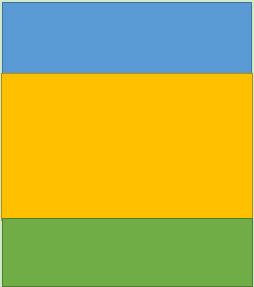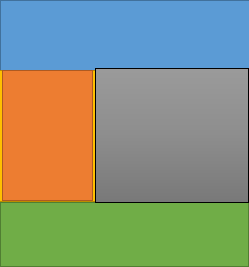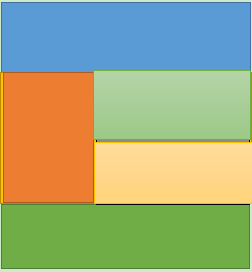“盒子的嵌套布局”的版本间的差异
来自CloudWiki
| 第1行: | 第1行: | ||
| + | ==盒子嵌套练习== | ||
| + | ====第一步:用大盒子进行布局==== | ||
| + | *[[文件:W3-35.png|300px]] | ||
| + | *代码一: | ||
| + | <nowiki><!DOCTYPE > | ||
| + | <html> | ||
| + | <head> | ||
| + | <meta charset="utf-8" /> | ||
| + | <title>无标题文档</title> | ||
| + | <style type="text/css"> | ||
| + | *{margin:0;padding:0;} | ||
| + | .layer1{width:100%; height:100px; background:blue;color:white;text-align:center;} | ||
| + | .layer2{width:100%; height:200px; background:yellow;color:blue;text-align:center;text-align:center;} | ||
| + | .layer3{width:100%; height:130px; background:green;color:white;text-align:center;} | ||
| + | </style> | ||
| + | </head> | ||
| + | <body> | ||
| + | <div class="layer1"><h1>顶部</h1></div> | ||
| + | <div class="layer2"> | ||
| + | </div> | ||
| + | <div class="layer3">底部</div> | ||
| + | </body> | ||
| + | </html></nowiki> | ||
| + | ====第二步:大盒子中嵌套小盒子==== | ||
| + | *[[文件:w3-38.png|300px]] | ||
| + | =====提示:===== | ||
| + | *在盒子的嵌套中, | ||
| + | *当盒子内部的元素需要竖直排列时,不需要增加额外的属性。 | ||
| + | *当盒子内部的元素需要水平排列时,要给需要浮动的元素添加float属性;同时,要在盒子内部的最后,增加一个空白盒子,将其属性设置为clear:both。 | ||
| + | *例子:下文中的代码2 | ||
| + | *代码2: | ||
| + | <nowiki> <!DOCTYPE > | ||
| + | <html> | ||
| + | <head> | ||
| + | <meta charset="utf-8" /> | ||
| + | <title>无标题文档</title> | ||
| + | <style type="text/css"> | ||
| + | *{margin:0;padding:0;} | ||
| + | .layer1{width:100%; height:100px; background:blue;color:white;text-align:center;} | ||
| + | .layer2{width:100%; height:200px;} | ||
| + | |||
| + | .layer2-1{width:30%; height:200px; background:red;text-align:center;float:left;} | ||
| + | .layer2-2{width:70%; height:200px; background:orange;text-align:center;float:left;} | ||
| + | .clear{clear:both;} | ||
| + | .layer3{width:100%; height:130px; background:green;color:white;text-align:center;} | ||
| + | </style> | ||
| + | </head> | ||
| + | <body> | ||
| + | <div class="layer1"><h1>顶部</h1></div> | ||
| + | <div class="layer2"> | ||
| + | <div class="layer2-1"><h2>中间左部</h2></div> | ||
| + | <div class="layer2-2"><h2>中间左部</h2></div> | ||
| + | <div class="clear"></div> | ||
| + | </div> | ||
| + | <div class="layer3">底部</div> | ||
| + | </body> | ||
| + | </html></nowiki> | ||
| − | == | + | ====第三步:小盒子中嵌套更小的盒子。。。==== |
| − | + | *[[文件:w3-39.png|300px]] | |
| − | == | + | *代码3: |
| − | + | <nowiki><!DOCTYPE > | |
| − | + | <html> | |
| − | |||
| − | |||
| − | |||
| − | |||
| − | |||
| − | |||
| − | |||
| − | |||
| − | |||
| − | *[[文件:w3- | ||
| − | * | ||
| − | |||
| − | <html | ||
<head> | <head> | ||
| − | <meta | + | <meta charset="utf-8" /> |
<title>无标题文档</title> | <title>无标题文档</title> | ||
<style type="text/css"> | <style type="text/css"> | ||
*{margin:0;padding:0;} | *{margin:0;padding:0;} | ||
| − | + | .layer1{width:100%; height:100px; background:blue;color:white;text-align:center;} | |
.layer2{width:100%; height:200px;} | .layer2{width:100%; height:200px;} | ||
| − | .layer2-1{width: | + | .layer2-1{width:30%; height:200px; background:red;text-align:center;float:left;} |
| − | .layer2-2{width:100%; height:100px; background: | + | .layer2-2{width:70%; height:200px; float:left;} |
| + | .layer2-2-1{width:100%;height:100px;background:lightgreen;} | ||
| + | .layer2-2-2{width:100%;height:100px;background:lightblue;} | ||
| + | .clear{clear:both;} | ||
| + | .layer3{width:100%; height:130px; background:green;color:white;text-align:center;} | ||
</style> | </style> | ||
</head> | </head> | ||
<body> | <body> | ||
| − | + | <div class="layer1"><h1>layer1</h1></div> | |
<div class="layer2"> | <div class="layer2"> | ||
| − | <div class="layer2-1"><h2> | + | <div class="layer2-1"><h2>layer2-1</h2></div> |
| − | <div class="layer2-2"><h2> | + | <div class="layer2-2"> |
| − | + | <div class="layer2-2-1"><h2>layer2-2-1</h2></div> | |
| + | <div class="layer2-2-2"><h2>layer2-2-2</h2></div> | ||
| + | </div> | ||
| + | <div class="clear"></div> | ||
</div> | </div> | ||
| − | + | <div class="layer3"><h2>layer3</h2></div> | |
</body> | </body> | ||
</html></nowiki> | </html></nowiki> | ||
| + | *思考:以上代码中的 .layer2-2-2{width:100%;}是什么意思?是将layer2-2-2的宽度设置为谁的宽度的100%?是指整个页面的100%吗? | ||
| − | === | + | ===盒子内部元素的水平排列=== |
| − | + | *在盒子的嵌套中, | |
| − | + | *当盒子内部的元素需要水平排列时,要给需要浮动的元素添加float属性。 | |
| − | * | + | *同时,要在盒子内部的最后,增加一个空白盒子,将其属性设置为clear:both。 |
| − | + | *例子:上文中的代码2 | |
| − | |||
| − | |||
| − | |||
| − | * | ||
| − | |||
| − | |||
| − | |||
| − | |||
| − | |||
| − | * | ||
| − | + | *[[文件:W3-35.png|300px]] [[文件:w3-38.png|300px]] [[文件:w3-39.png|300px]] | |
| − | |||
| − | |||
| − | |||
| − | |||
| − | *[[文件: | ||
| − | |||
| − | |||
| − | |||
| − | |||
| − | |||
| − | |||
| − | |||
| − | |||
| − | |||
| − | |||
| − | |||
| − | |||
| − | |||
| − | |||
| − | |||
| − | |||
| − | |||
| − | |||
| − | |||
| − | |||
| − | |||
| − | |||
| − | |||
| − | |||
| − | |||
| − | |||
| − | |||
| − | |||
| − | |||
| − | |||
| − | |||
| − | |||
| − | |||
2019年10月27日 (日) 13:31的版本
盒子嵌套练习
第一步:用大盒子进行布局
<!DOCTYPE >
<html>
<head>
<meta charset="utf-8" />
<title>无标题文档</title>
<style type="text/css">
*{margin:0;padding:0;}
.layer1{width:100%; height:100px; background:blue;color:white;text-align:center;}
.layer2{width:100%; height:200px; background:yellow;color:blue;text-align:center;text-align:center;}
.layer3{width:100%; height:130px; background:green;color:white;text-align:center;}
</style>
</head>
<body>
<div class="layer1"><h1>顶部</h1></div>
<div class="layer2">
</div>
<div class="layer3">底部</div>
</body>
</html>
第二步:大盒子中嵌套小盒子
提示:
- 在盒子的嵌套中,
- 当盒子内部的元素需要竖直排列时,不需要增加额外的属性。
- 当盒子内部的元素需要水平排列时,要给需要浮动的元素添加float属性;同时,要在盒子内部的最后,增加一个空白盒子,将其属性设置为clear:both。
- 例子:下文中的代码2
- 代码2:
<!DOCTYPE >
<html>
<head>
<meta charset="utf-8" />
<title>无标题文档</title>
<style type="text/css">
*{margin:0;padding:0;}
.layer1{width:100%; height:100px; background:blue;color:white;text-align:center;}
.layer2{width:100%; height:200px;}
.layer2-1{width:30%; height:200px; background:red;text-align:center;float:left;}
.layer2-2{width:70%; height:200px; background:orange;text-align:center;float:left;}
.clear{clear:both;}
.layer3{width:100%; height:130px; background:green;color:white;text-align:center;}
</style>
</head>
<body>
<div class="layer1"><h1>顶部</h1></div>
<div class="layer2">
<div class="layer2-1"><h2>中间左部</h2></div>
<div class="layer2-2"><h2>中间左部</h2></div>
<div class="clear"></div>
</div>
<div class="layer3">底部</div>
</body>
</html>
第三步:小盒子中嵌套更小的盒子。。。
<!DOCTYPE >
<html>
<head>
<meta charset="utf-8" />
<title>无标题文档</title>
<style type="text/css">
*{margin:0;padding:0;}
.layer1{width:100%; height:100px; background:blue;color:white;text-align:center;}
.layer2{width:100%; height:200px;}
.layer2-1{width:30%; height:200px; background:red;text-align:center;float:left;}
.layer2-2{width:70%; height:200px; float:left;}
.layer2-2-1{width:100%;height:100px;background:lightgreen;}
.layer2-2-2{width:100%;height:100px;background:lightblue;}
.clear{clear:both;}
.layer3{width:100%; height:130px; background:green;color:white;text-align:center;}
</style>
</head>
<body>
<div class="layer1"><h1>layer1</h1></div>
<div class="layer2">
<div class="layer2-1"><h2>layer2-1</h2></div>
<div class="layer2-2">
<div class="layer2-2-1"><h2>layer2-2-1</h2></div>
<div class="layer2-2-2"><h2>layer2-2-2</h2></div>
</div>
<div class="clear"></div>
</div>
<div class="layer3"><h2>layer3</h2></div>
</body>
</html>
- 思考:以上代码中的 .layer2-2-2{width:100%;}是什么意思?是将layer2-2-2的宽度设置为谁的宽度的100%?是指整个页面的100%吗?
盒子内部元素的水平排列
- 在盒子的嵌套中,
- 当盒子内部的元素需要水平排列时,要给需要浮动的元素添加float属性。
- 同时,要在盒子内部的最后,增加一个空白盒子,将其属性设置为clear:both。
- 例子:上文中的代码2


